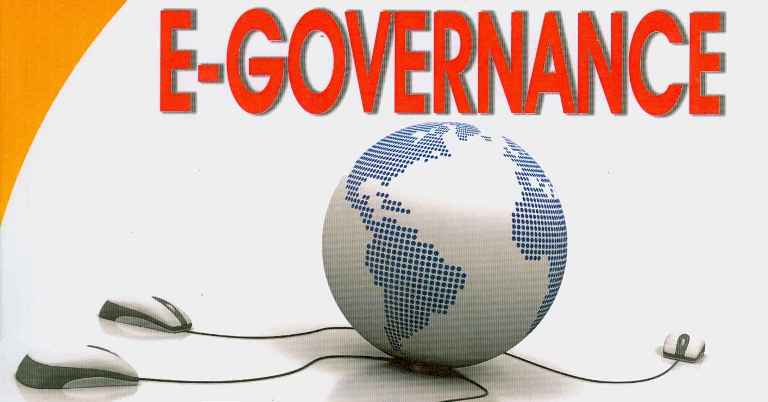E-governance – Management Notes For W.B.C.S. Examination.
ই-গভর্নেন্স – WBCS পরীক্ষার জন্য ম্যানেজমেন্টের নোট ।
E-Governance has become an essential part of any firm in globalisation process. Increasing demands of clearness in administration, rapid information transfer, more competent performance and improved public service has pushed organizations to choose electronic means for success in business. Organizations can give better performance through innovative use of information technology and e-governance. There are many advantages of e-governance and impact public management through, for example, improved access to services, decreased operational costs, enhanced knowledge management, and strengthened coordination of government agencies. E-government has been major developments of the web. It is well established that Internet supported digital communities, they present the national governments with a number of challenges and opportunities. The application of ICT and e-governance has huge potential for intermediate organizations in developing countries. The main goal of e-governance is to support and simplify governance for all parties’ government, citizens and businesses. E-governance uses electronic medium to support and motivate good governance. Therefore the purpose of e-governance are analogous to the objectives of good governance. Good governance can be seen as an application of economic, political, and administrative authority to smoothly manage business activities of a country at, national and local level.Continue Reading E-governance – Management Notes For W.B.C.S. Examination.
Concept of E-Governance
E-governance is the good usage of information and communication technologies to transform and enhance the efficiency, effectiveness, transparency and accountability of informational and transactional exchanges with in government, between government agencies at National, State, Municipal & Local levels, citizen & businesses, and to authorise citizens through access and use of information. Fundamentally, E-governance, entails electronic governance which uses information and communication technologies at various levels of the government and the public sector to improve governance (Bedi, Singh and Srivastava, 2001). Theoretical studies demonstrated that E-Governance is the process of change of the relationship of government with its constituents the citizens, the businesses and between its own organs, through the use of tools of information and communication technology. Keohane and Nye (2000) asserted that “Governance implies the processes and institutions, both formal and informal that guide and restrain the collective activities of a group.
Government is the subset that acts with authority and creates formal obligations. Governance need not necessarily be conducted exclusively by governments. Private firms, associations of firms, nongovernmental organizations (NGOs), and associations of NGOs all engage in it, often in association with governmental bodies, to create governance and sometimes without governmental authority.” The objective of e governance is to embrace information and communication technologies and offer an opportunity to citizens, so they can get involve in decision making process. According to The UNESCO, E-governance is the public sector’s use of information and communication technologies in order to enhance information and service delivery, motivating inhabitant involvement in the decision-making process and making government more accountable, transparent and effective. E-governance involves new styles of management, novel ways to decide policy and investment, new ways of accessing education, and listening to citizens and new ways of organizing and delivering information and services. The purpose is to give better access, accountability and efficiency in the delivery of government information and services. E-Governance has capability to provide all government information and services on internet to the public and private sector. An e-governance initiatives and innovations will ensure a more democratic, transparent and accountable framework for the public and private apparatus to operate in. The governments of developing countries must establish a suitable environment for e-governance. E-governance is the method of service delivery and information dissemination to citizens using electronic means providing many benefits over the conventional system (Jayaradha and Shanthakumar, 2003). These include increased efficiency in various Governmental processes, transparency and anticorruption in all transactions, empowerment of citizens and encouragement of their participation in governance. Ray and Dash (2015) considered that e-governance should also include the aspects of internal working which cover use of information technology to increase competence and effectiveness of internal functions and internal communications and internetworking. Internal aspects cover the overall change of government hierarchy to adjust to the new requirements and expectations of efficient and improved services, simplification and rationalization in the business process to better serve the stake-holders in a transparent and cost-effective manner.
Historical evaluation of E-governance
With the technical development of internet technology in the nineties, there was global shifts towards increased deployment of IT by governments. The technology as well as e-governance initiatives emerged a long way since that time. World Wide Web offered good opportunities to global population to exploit their new mode of access in wide ranging ways. People have great expectation to get information and services online from governments and corporate organizations to further their civic, professional and personal lives, thus creating plentiful evidence that the new “e-citizenship” is taking hold. In India, the notion of e-governance during the seventies with a focus on development of in-house government applications in the areas of defence, economic monitoring, planning and the deployment of IT to manage data intensive functions related to elections, census, and tax administration. The National Informatics Center made great efforts to link all the district headquarters in the decade of eighties. Since the beginning of nineties, IT technologies were enhanced by information and communication technology to expand its use for wider sectorial applications with policy emphasis on reaching out to rural areas and taking in greater participations from NGOs and private sectors.
Please subscribe here to get all future updates on this post/page/category/website


 +919674493673
+919674493673  mailus@wbcsmadeeasy.in
mailus@wbcsmadeeasy.in







































































































